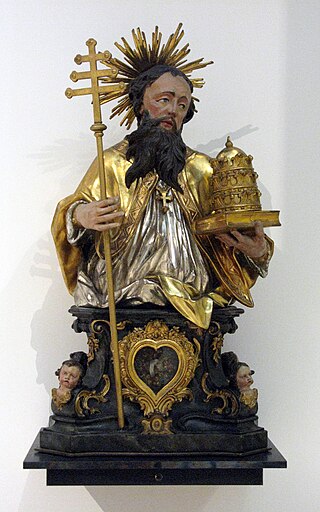
Pope Linus was the bishop of Rome from c. AD 68 to his death. He is generally regarded as the second Bishop of Rome, after St. Peter. As with all the early popes, he was canonized.
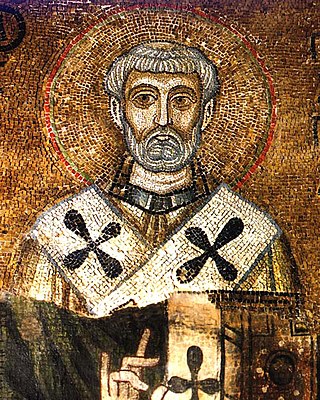
Clement of Rome, also known as Pope Clement I, was a bishop of Rome in the late first century AD. He is considered to be the first of the Apostolic Fathers of the Church, and a leading member of the Church in Rome in the late 1st century.

In Ancient Roman architecture, a basilica was a large public building with multiple functions that was typically built alongside the town's forum. The basilica was in the Latin West equivalent to a stoa in the Greek East. The building gave its name to the basilica architectural form.

The Catacombs of Rome are ancient catacombs, underground burial places in and around Rome, of which there are at least forty, some rediscovered only in recent decades.

Saint Valentine was a 3rd-century Roman saint, commemorated in Western Christianity on February 14 and in Eastern Orthodoxy on July 6. From the High Middle Ages, his feast day has been associated with a tradition of courtly love. He is also a patron saint of Terni, epilepsy and beekeepers. Saint Valentine was a clergyman – either a priest or a bishop – in the Roman Empire who ministered to persecuted Christians. He was martyred and his body buried on the Via Flaminia on February 14, which has been observed as the Feast of Saint Valentine since at least the eighth century.

Saint Lawrence or Laurence was one of the seven deacons of the city of Rome under Pope Sixtus II who were martyred in the persecution of the Christians that the Roman Emperor Valerian ordered in 258.
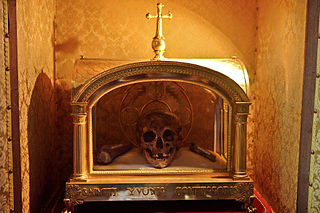
In religion, a relic is an object or article of religious significance from the past. It usually consists of the physical remains or personal effects of a saint or other person preserved for the purpose of veneration as a tangible memorial. Relics are an important aspect of some forms of Buddhism, Christianity, Islam, shamanism, and many other religions. Relic derives from the Latin reliquiae, meaning "remains", and a form of the Latin verb relinquere, to "leave behind, or abandon". A reliquary is a shrine that houses one or more religious relics.

Saint Peter's tomb is a site under St. Peter's Basilica that includes several graves and a structure said by Vatican authorities to have been built to memorialize the location of Saint Peter's grave. St. Peter's tomb is alleged near the west end of a complex of mausoleums, the Vatican Necropolis, that date between about AD 130 and AD 300. The complex was partially torn down and filled with earth to provide a foundation for the building of the first St. Peter's Basilica during the reign of Constantine I in about AD 330. Though many bones have been found at the site of the 2nd-century shrine, as the result of two campaigns of archaeological excavation, Pope Pius XII stated in December 1950 that none could be confirmed to be Saint Peter's with absolute certainty. Following the discovery of bones that had been transferred from a second tomb under the monument, on June 26, 1968, Pope Paul VI said that the relics of Saint Peter had been identified in a manner considered convincing. Only circumstantial evidence was provided to support the claim.

April 14 - Eastern Orthodox liturgical calendar - April 16

Pancras was a Roman citizen who converted to Christianity and was beheaded for his faith at the age of fourteen, around the year 304. His name is Greek (Πανκράτιος) and means "all-powerful".

Saint Anastasia is a Christian saint and martyr who died at Sirmium in the Roman province of Pannonia Secunda. In the Eastern Orthodox Church, she is venerated as St. Anastasia the Pharmakolytria, i.e. "Deliverer from Potions". This epithet is also translated as "One who Cures (Wounds)" in Lampe's A Patristic Greek Lexicon.
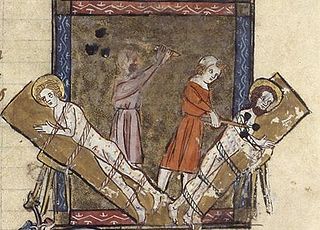
Gervasius and Protasius are venerated as Christian martyrs, probably of the 2nd century. They are the patron saints of Milan and of haymakers and are invoked for the discovery of thieves. Their feast day in the Latin Rite of the Catholic Church is 19 June, the day marking the translation of their relics. In the Eastern Orthodox Church and in the Eastern Rites of the Catholic Church, their feast takes place on 14 October (O.S.)/24 October (N.S.), the traditional day of their death. In Christian iconography their emblems are the scourge, the club and the sword.

The Four Crowned Martyrs or Four Holy Crowned Ones were nine individuals who are venerated as martyrs and saints of Early Christianity. The nine saints are divided into two groups:
- Severus, Severian(us), Carpophorus (Carpoforus), Victorinus
- Claudius, Castorius, Symphorian (Simpronian), Nicostratus, and Simplicius

The Italian Catholic Church, or Catholic Church in Italy, is part of the worldwide Catholic Church in communion with the Pope in Rome, under the Conference of Italian Bishops. The pope serves also as Primate of Italy and Bishop of Rome. In addition to the Italian Republic, two other sovereign states are included in Italian dioceses: San Marino and Vatican City. There are 225 dioceses in the Catholic Church in Italy, see further in this article and in the article List of Catholic dioceses in Italy.

Martinian and Processus were Christian martyrs of ancient Rome. Neither the years they lived nor the circumstances of their deaths are known. They are currently buried in St. Peter's Basilica in Rome.

Saint Praxedes, called "a Roman maiden", was a saint and virgin who lived in the Roman Empire during the 2nd century. Along with her sister, Saint Pudentiana, she provided for the poor and gave care and comfort to persecuted Christians and martyrs. Her veneration began in the 4th century and many churches have been dedicated to her.
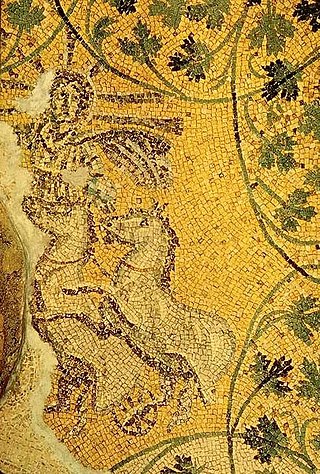
The Vatican Necropolis lies under the Vatican City, at depths varying between 5–12 metres below Saint Peter's Basilica. The Vatican sponsored archaeological excavations under Saint Peter's in the years 1940–1949 which revealed parts of a necropolis dating to Imperial times. The work was undertaken at the request of Pope Pius XI who wished to be buried as close as possible to Peter the Apostle. It is also home to the Tomb of the Julii, which has been dated to the third or fourth century. The necropolis was not originally one of the Catacombs of Rome, but an open-air cemetery with tombs and mausolea.
Anastasia the Roman was 3rd-century Christian saint and nun who was martyred during the reign of Roman emperor Decius.

Saint Peter, also known as Peter the Apostle, Simon Peter, Simeon, Simon, or Cephas, was one of the Twelve Apostles of Jesus Christ and one of the first leaders of the early Christian Church. He appears repeatedly and prominently in all four New Testament gospels as well as the Acts of the Apostles. Catholic tradition accredits Peter as the first bishop of Rome—or pope—and also as the first bishop of Antioch.

Stephen is traditionally venerated as the protomartyr or first martyr of Christianity. According to the Acts of the Apostles, he was a deacon in the early church at Jerusalem who angered members of various synagogues by his teachings. Accused of blasphemy at his trial, he made a speech denouncing the Jewish authorities who were sitting in judgment on him and was then stoned to death. Saul of Tarsus, later known as Paul the Apostle, a Pharisee and Roman citizen who would later become an apostle, participated in Stephen's martyrdom.



















